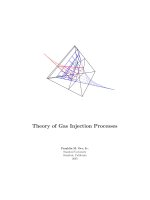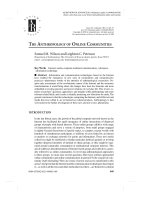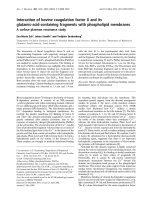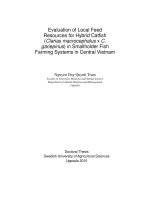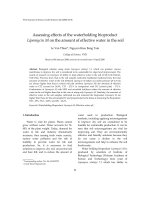Compaison of grow, feed conversion adsuv of morone saatli femae x m misisippiensi mae ad m satlifemae x m chrsops mae hybrids reaedin recircu
Bạn đang xem bản rút gọn của tài liệu. Xem và tải ngay bản đầy đủ của tài liệu tại đây (2.91 MB, 15 trang )
Comparison of Growth, Feed Conversion and
Survival of Morone saxatilis female x M.
mississippiensis male and M. saxa tilis
female x M. chrysops male Hybrids Reared
in Recirculating Aquaculture Systems
B.G. Bosworth*!, G.S. Libey1 �W.R. Wolters2
1
Department of Fisheries and Wildlife Sciences
Institute and State University
Vu-ginia Polytechnic
Blacksburg, VA 24061 USA
2
Catfish Genetics Research Unit
USDA-Agricultural Research Service
P.O.Box38
Stoneville, MS 38776 USA
*Corresponding author, present address:
Catfish Genetics Research Unit
USDA-Agricultural Research Service
P. 0. Box 38
Stoneville, MS 38776 USA
ABSTRACT
Striped bass female (M. saxatilis) x white bass male (M. mississippi
ensis), (SBxWB, n = 300) and striped b ass female x yellow bass male
(M. chrysops) (SBxYB, n = 300) fingerlings, initial mean weight 91 g
and 62 g, respectively, were reared in recirculating aquaculture systems
at densities of 118 fish/m3 for 120 days. Mean weight increased 309 g
and 151 gin SBxWB and SBxYB, respectively. :final mean weight and
total length, and rate of weight and length incre as e were highe r for
SBxWB than SBxYB. Condition factor and survival were higher for
SBxYB (l.04 and 99.3%, respectively) than for SBxWB (1.01 and
96.0%, respectivel y). Mean feed conversion ratio (FCR) was lower for
SBxWB (1.4) than for SBxYB (1.6). Significant time x hybrid
interactions indicated that growth rate of SBxYB improved, relative to
SBxWB, as the study progressed. Positive linear trends for total
ammonia, unionized ammonia, and nitrite indicate water quality
deteriorated as the study progressed. Time x hybrid interactions for
International Journal of Recirculating Aquaculture, volume 2
21
growth rate may have been due to differential responses of SBxYB and
SBxWB to deterioration of water quality. Although SBxYB had slightly
better survival than SBxWB and their growth rate improved relative to
that of SBxWB, the slow overall growth of SBxYB limits its potential
for recirculating system production.
INTRODUCTION
Hybrids among species of the genus Morone appear to have good
potential for commercial aquaculture (Van Olst and Carlberg 1990). All
crosses attempted among the four Morone species endemic to North
America [striped bass (M. saxatilis), white bass (M. chrysops), white
perch (M. americanus), and yellow bass (M. mississippiensis)] have
produced viable offspring (Kerby and Harrell 1990). The interspecies
fertility of Morone allows production of a variety of species crosses, but
the majority of studies have focused on evaluation of production traits of
striped bass x white bass, F1 hybrids. Compared to pure striped bass,
striped x white bass hybrids (SBxWB) exhibit superior growth, disease
resistance, survival and feed conversion (Logan 1968; Ware 1975; Smith
et al. 1985; Kerby 1986; Tuncer et al. 1990).
Striped Bass x White Bass (SBxWB) hybrids generally have been
superior to other Morone species hybrids in pond or flow-through
production systems (Kerby and Joseph 1979, Kerby et al. 1987a, Zhang
et al. 1994, Wolters and DeMay 1996). However, little information is
available on performance of different Morone hybrids in the recirculating
aquaculture system (RAS) environment. In RAS, water is filtered and
reused, allowing production of more fish per unit volume of water used
than in pond or flow-through systems. Due to high fish densities and low
water exchange rates, maintenance of optimal water quality in RAS is
problematic (Lucchetti and Gray 1988). Therefore, RAS represent a
different environment than pond or flow-through systems. Striped Bass x
Yellow Bass (SBxYB) hybrids may be useful for RAS production if they
are more tolerant of poor water quality or are generally hardier than
SBxWB. The objective of this study was to compare growth, feed
conversion, and survival of SBxYB and SBxWB reared in RAS.
22
International Journal of Recirculating Aquaculture, volume 2
MATERIALS AND METHODS
RAS Design
The rearing system consisted of two, 1.2 m diameter
fiberglass
(840 L capacity)
tanks , a rotating biological contactor filter (RBC) and a sump.
The RBC, which provided a substra te for nitrifying bacteria, was
constructed from polyvinyl chloride disks (Bl0deck12060, Munters
Corp., Fort Myers, FL.USA). Rotating biologi cal contactor (RBC) disks
were connected to an aluminum shaft, which was rotated at 6 RPM by a
1/4 HP electric motor. The sump contained a multi-tube clarifier and a
four inch layer of crushed oyster shell to facilitate collection of
particulate matter. A submersible pump, located in the sump, circulated
water through the system at 30 Uminute/tank. Aeration was provided by
a surface agitator in each tank. Three replicate systems were used in the
study.
Fish and Husbandry
Striped bass females from Toledo Bend Reservoir, Louisiana (USA),
and yellow bass males from several lakes in Louisiana were used to
produce SBxYB. Striped bass females from the Roanoke River, VA,
USA; and
white bass males from the Hyco River, VA, USA, w ere used to
produce SBxWB. Prior to the study, S BxWB were reared in 5.8m
diameter, circular fiberglass tanks at the Aquaculture Research Facility at
Virginia Polytechnic Institute and State University (Blacksburg, VA,
USA). SBxYB were initially reared in ponds at Ben Hur Research Farm,
Louisiana State University, Baton Rouge, LA, USA. SBxYB hybrids
were removed from ponds , transported to the Aquac ulture Research
Facility at Virginia Tech and acclimated to tank conditions for 7 weeks
prior to initiation of this study. After the acclimation period SBx YB and
SBxWB fingerlings were weighed, measure d for total len gth, and
stocked in separate tanks in each system at a densi t y of 118 fish/m3 ( 100
fish/tank). A total of 300 fingerlings from each hybrid were used in this
study.
w ere fed a 44% protein, floatin g pellet (Biosponge, Sheridan,
WY, USA) to sati ation twice daily. Weight of feed consumed by fish in
each tank was recorded after each feedi n g. S umps were drained and
Fish
rinsed periodically to remove collected partic ulate matter. Sodium
International Journal of Recirculating Aquaculture, volume 2
23
bicarbonate was added to increase water alkalinity to 150 ppm
fell below 75 ppm.
Data Collection
if levels
and Analysis
A portable meter (YSI Co., Yellow Springs, OH, USA) was used to
measure water temperature and dissolved oxygen in eac h tank daily.
Total
ammonia
alkalinity were
nitrogen (TAN), nitrite (N02-N), pH and
measured 3 times per week, and water hardness and nitrate (N03-N)
TAN, N�-N. and N03-N were measured with a
(HACH Co., Loveland, CO, USA), pH was measured
with a HACH pH pen, and alkalinity and hardness were measured by
were measured weekly.
spectrophotometer
titration. Concentration of unionized
ammonia
(NH3-N)
was
calculated
according to Emmerson et al. (1975).
Fish were weighed, and measured for total leng th every 30 days.
Absolute growth rate for length and weight, FCR (feed conversion ratio),
and condition factor were determined for each 30 day period. SBxWB
and SBxYB hybrids differed for length and wei ght at the
beginning of
this study, and it was not known if the differences were due to
differences in pre-study environments or growth potential of hybrids. To
alleviate biases due to initial size differences, relative and instantaneous
growth rates for weight, which are less influenced by initial size
(Hopkins 1992), were included in the analysis. Traits were defined as
follows:
(W1 - W1)/ (T1 - T1),
relative weight gain= (Wt W1)/ (W ) x 100,
1
absolute length gain (L1 - L1)/ (T1 T1)�
FCR (feed consumed from T1_1 to T1)/ (W, W,).
condition factor= W/W
absolute wei ght gain
=
-
=
-
=
-
.._
weight at time t,
w._. = fish weight at time t-1,
W1
=
fish
L1 = length at time t,
L1_1 =length at time t-1,
T1
W1
1
=
number of days at time t,
T1_1
=
number of days at time t-1, and
W11
=
length-specific standard weight at time t.
was calculated using an equation developed for Morone hybrids by
Brown and Murphy
(1991).
24 International Journal of Recirculating Aquaculture, volume 2
A randomizCd
complete block design, with rearing system as the
as the treatment, was used to compare means
of traits of"SBxYB and SBxWB. Tank means for water quality ·variables.
growth traits, FCR an d condition factor for each 30 day interval were
analyzed with a repeated measures ANOVA (GLM Procedure, SAS
1985). Orthogonal polynomial contrasts, through the third degree, were
used to analyze trends in variables over. time. Polynomial coefficients for
all variables were estimated and tested for differences between hybrids
using procedures developed for repeated measures designs (Meredith and
Stehman 1991). Survival of the two hybrids was compared with a 2x2
contingency table, adjusted for system effects (Frequency Procedure,
SAS 1985}. A p-value of< 0.05 was considered significant in all
statistical analysis.
blocking factor· and hyb rid
RESULTS
Water Quality
Of the. water quality
variables measured, only pH differed between
hybrids, overall mean 7.9 and 7.8 (±0.01) for SBxYB and SBxWB,
respectively. Means (±SE} for other water quality variables were:
temperature 22.5°C (±0.01), dissolved oxygen 7.0 ppm (±0.01), rAN
0.64 ppm (±0.0l),NH3-N ppm 0 02 (±0.001), N02-N 0.26 ppm (±0 �n,
hardness 253.6 ppm (±3.0), and alkalinity 161 ppm (±LO}. Time x hybrid
interactions were not significant for any water quality variables.
Significant linear polynomial coefficients indicated water temperature,
TAN, NH3-N, NOi-N. NOrN. and hardness increased; and dissolved
oxygen and pH decreased as the study progressed. Polynomial
coefficients for water quality variables were not different between
·
.
..
•.
hybrids.
Growth, FCR, Condition Factor and Survival
Mean weight, length, and all measures of growth rate were higher for
SBxWB than SBxYB (Table 1). Timex hybrid interactions were
significant for all measures of growth rate, and indicated that growth rate
of SBxYB improved,
study.
relative to growth rate of SBxWB, during the
International Journal �f Recirculating Aquaculture, volume .2
25
·
Table 1. Means (:J:.SE)for weight, length, absolute weight gain (AWG), relative weight gain
(RWG), absolute length gain (AW), feed conversion ratio (FCR), condition factor, and
survival for striped bass x yellow bass (SBxYB) and striped bass x white bass (SBxWB).
Time
DayO
SBxYB
SBxWB
(SE)
Weight (g) Length
(mm) AWG(g/day)
RWG(%)
61.6
91.7
(1.0)
166
1 94
(1)
95.8
173.3
(6.1)
189
227
(1)
1.1
2.7
(0.2)
55.9
88.7
(5.8)
130.7
265.1
(1.8)
208
259
(1)
l.2
3.1
(0.1)
38.I
53.9
(2.9)
228
28 5
(1)
1.3
2.4
(0.3)
29 5
27.l
(1.0)
243
1.4
304
(1)
2.1
(0.2)
24.7
18.7
(1.7)
1.3
2.6
(0.02)
37.1
47.1
(0.8)
{H,TxH)
(T,H,TxH)
Day0-30
SBxYB
SBxWB
(SE)
Day30-60
SBxYB
SBxWB
(SE)
Day60-90
SBxYB
170.3
SB xWB
(SE)
336.9
(3.2)
Day 90-120
SBxYB
SBxWB
(SE)
212.2
400. 1
(2.2)
Overall Mean
SBxYB
SBxWB
(SE)
E1Tects1
1
{T,H,TxH)
(T,H,TxH)
Effects of time (T), hybrid (H), or time x hybrid interactions (TxH)
significant at P < 0.05
26
.
International Journal of Recirculating Aquaculture, volume 2
ALG (mm/day)
FCR
Condition Factor Survival ( %)
0.99
0.91
(0.02)
0.8
1.1
(0.02)
0.7
I.I
(0.03)
1.3
1.0
(1.0)
1.04
1 .06
(0.02)
100
100
1.5
1.1
(0.02)
1.08
1.08
(0.02)
100
99.7
(0.3)
0.7
1.6
0.9
(0.02)
1.6
(0.02)
1.04
1.03
(0.01)
100
99.3
(0 . 1)
0.5
0.6
(0.04)
1.9
2.1
(0.21)
1.06
0.99
(0.01)
99.3
96.0
(0.2)
0.7
0.9
(0.01)
1.6
1.4
(0.04)
1.02
(0.004)
(T,H,TxH)
(T,H)
(T,H,TxH)
1.04
(H)
International Journal of Recirculating Aquaculture, volume 2
27
·
Table 2. Polynomial coefficients for weight, length, absolute weight gain (AWG), relative weight gain (RWG), absolute length gain (ALG),
feed conversion ratio (FCR), and condition/actor for striped bass x yellow bass (SBxYB) and striped bass x white bass (SBxWB).
AWG
(g/day)
RWG
ALG
(mm/day)
FCR
(g)
Length
(mm)
Linear
37.6*
19.6*
0.1
0.01
1.3
-1.1 *
-0.1*
0.2*
Quadratic
-0.01
0.1
-0.1
0.0
10 2*
3.2
-0.9
0.0
-0.05
-0.01
-0.01
0. 1
0.04
78.2*
-4.2*
-1.5
27.8*
-2.5*
-0.5*
-0.3*
-0.2*
0.01
0.4*
L
L,Q,C
Polynomial
coefticients1.z
Weight
SBxYB
Cubic
(%)
-
.
Condition
Factor
SBxWB
Linear
Quadratic
Cub ic
SBxYB vs. SBxWB
-0.03*
0.1
0.02
0.01
-0.03
L
L
L,Q
-0.2
.
represent change per time period,
2 L, Q, C indicate that linear, quadratic or cubic coefficients differed between SBx YB and SBxWB.
* indi cates that the coefficient is different from 0 at P < 0.05.
1
Values of coefficients are scaled to
-0.l*
-0 2
-23.6*
6.6
1.7
Mean weight increased 309.2 g and 150.6 gin SBxWB and SBxYB,
respectively, during the study. Overall mean-(day 0-120) absolute weight
gain, relative weight gain, and instantaneous rate of weight gain were
2.57 g/day, 338.1%, and 1.23 g/day, respectively, for SBxWB; and 1.26
g/day, 248.9%, and 1.03 g/day, respectively, for SBxYB. Absolute
weight gain was highest (3.1 g/day) for SBxWB from day 30 to 60, and
lowest (2.1 g/day) from day 90-120. Absolute weight gain of SBxYB
was lowest (1.1 g/day) from day 0-30 and highest (1.4 g/day) from day
90-120.
Overall mean FCR was lower for SBxWB (1.4) than for SBxYB (1.6).
The time x hybrid interaction was not significant for FCR. Feed
conversion ratios were lowest from day 0-30 and highest from day 90120 for both hybrids. Overall mean condition factor was higher for
SBxYB (1.04) than for SBxWB (1.01). Timex hybrid interaction was
significant for condition factor. Condition factor was lowest at the
beginning of the study, and highest at day 60 in both hybrids. Survival of
_SBxYB (99.3 %) was higher than survival of SBx WB (96.0%).
Linear polynomial coefficients (Table 2) were positive for mean
weight and length, and negative for relative weight gain in both hybrids.
Linear coefficients were negative for absolute weight gain in SBxWB,
but not different from zero in SBxYB. Quadratic coefficients were
negative for length in both hybrids; and negative for absolute length gain
and condition factor in SBxWB. Hybrids differed for linear coefficients
for mean length, mean weight, and all measures of growth rate; quadratic
coefficients for mean length and absolute length increase; and cubic
coefficients for mean length. Linear coefficients for mean length and
weight were greater for SBxWB than SBxYB. Linear coefficients
absolute and relative weight gain were lower for SBxWB than SBxYB,
indicating growth rate of SBxYB improved, relative to SBxWB, as the
study progressed.
DISCUSSION
Because of its economic importance and ease of interpretation,
researchers often include only rate of absolute weight gain in results of
Morone growth trials. To facilitate comparison of the results of this study
with other studies, the discussion of growth focuses primarily on
absolute weight gain. Differences between hybrids for other measures of
International Journal of Recirculating Aquaculture, volume 2
29
weight gain (relative and instantaneous) were similar to absolute weight
gain; i.e. SBxWB had superior overall growth,but growth of SBxYB
improved, relative to SBxWB, as the study progressed.
Mean absolute growth rate of SBxWB in this study (2.6 g/day), was
similar to rates of 1.7-2.8 g/day (Nunley 199 2) and 2 . 6 g/day (Smith et
al. 1985) reported for similar size SBxWB reared in RAS. Growth rates
of SBxWB reared in ponds, cages and flow-through systems range from
0.9 to 2.2 g/day (Williams et al. 1981; Woods et al. 1983; Kerby et al.
1987b; Zhang et al. 1994, Wolters and DeMay 1996) , and are typically
lower than growth rates of SBxWB reared in RAS. Mean FCR for
SBxWB in this study ( 1.41) was at the lower end of the range of FCRs
(1.3-2.4) reported for SBxWB in other studies (Woods et al. 1983; Smith
et al. 1985; Kerby et al. 1987 ; Nunley 1992). A pattern of increased FCR
with increased fish size was observed in both hybrids, and is typical for
fish (Brett 1979). Survival of SBxWB, 96%, was similar to survival of
SBxW B in other RAS trials,> 90% (Smith et al. 1985 ; Nunley 1992),
and generally higher than survival of SBxWB (47%-95%) observed in
previously cited pond and flow-through trials.
Absolute weight gain, FCR, and survival (1.26 g/day, 1.59, and 99.3%,
respectively) of SBxYB in this study, were superior to the same traits for
SBxYB reare d in pond water, flow-through systems (0.59 g/day, 3.8, and
64. 7 %, respectively, DeMay and Wolters 1996), and in s tati c ponds (1.17
g/day, 1.48, and 74.0%, respectively, Zhang et al. 1994). Our results and
those of Zhang et al. ( 1 99 4) and Wolters and DeMay (1996) indicate that
SBxWB grow faster than SBxYB in all rearing environments tested. The
difference in survival of SBxYB and SBxWB observed in this study was
significant but small (3.3%). However, fish from this study were
maintained in tanks for further studies and mortalities of SBxWB
increased to about 20% while mortalities of SBxYB remained near zero
during this time.
For the size range of fish use d in this study, absolute weight gain of
pond-reared SBxWB increased or stabilized as fish size increased.
However, in this and other RAS studies (Smith et al. 1985; Nunley 1992)
declines in growth of SBxWB have been reported. In contrast, absolute
weight gain of SBxYB increased slightly over time. The presence of time
x hybrid interactions for measure of weight gain in RAS, and the lack of
similar interactions in flow-through systems (Wolters and DeMay 1996)
30
International Journal of Recirculating Aquaculture, volume 2
suggest that genotype x rearing environment interactions influence
performance of Morone hybrids.
Prolonged exposure fo deteriorated water quality has been proposed as
the cause of the decreased growth rates observed in SBxWB reared in
RAS (Smith et al. 1985; Nunley 1m). Specific water quality variables
responsible for inhibiting growth
of S BxWB in RAS have not been
identified, but unionized ammonia (NH3-N), nitrite (N02-N) and
dissolved organics have been implicated in inhibiting growth of other
intensively reared fishes (Robinette 1976; Colt and Armstrong 1981;
Sodeberg et al. 1983; Hirayama et al. 1988). Levels of NH3-N, N02-N
and dissolved organics
are
expected to increase with time in RAS, due to
increases in fish biomass and feed inputs (Easter
1992). Dissolved
organics were not measured in this study, but NH3-N and N02-N did
increase as this study progressed, and may have resulted in the reduced
absolute growth rate observed in SBxWB.
Regardless of the specific cause, it appears SBx YB were less
negatively impacted by prolonged exposure to the RAS environment
than SBxWB. Water quality was similar for both hybrids, thus the
differences in growth patterns between hybrids appeared to be due to
different responses to a common environment. Different responses of
SBxWB and SBxYB to deteriorating water quality seems to be the most
probable explanation for the time x hybrid interactions for growth.
Potential confounding factors in this study were the use of different
striped bass parental stocks in the two hybrids and differences in pre
study rearing environments. We were unable to use the same striped bass
parental stocks due to differences in the availability of reproductively
mature fish from the required male and female species. However,
Wolters and DeMay (1996) observed similar differences in growth
(SBxWB grew faster than SBxYB) using striped bass female parents
from a common stock, suggesting the differences we observed were
more likely due to differences in
male parental species used than striped
bass female stocks used as parents. There were differences in pre-study
rearing environments between the two groups of fish, but
all fish were
reared in the RAS environment for 7 weeks prior to beginning data
collection� which should have helped to reduce pre-study environmental
differences.
International Journal of Recirculating Aquaculture, volume 2
31
The apparent superior resistance of SBxYB to prolonged exposure to
the RAS environment may be of some benefit. However, the slow
growth of SBxYB limits their commercial aquaculture potential.
Incorporation of yellow bass genome in Morone crossbreeding programs
would be beneficial if hardiness of progeny can be improved, without
unacceptable decreases in growth rate. Design of appropriate
crossbreeding strategies, c o upled with improved water treatment
technology, should result in improved fish growth, and improve
economic feasibility of RAS culture of Morone.
32
International Journal of Recirculating Aquaculture, volume 2
REFERENCES
Brett, J.R. Bioenergetics and Growth. In Fish Physiolo&)'. Volume VIII.
Hoar, W.S., Randall, D.J., and Brett, J.R., Eds. 1979. Ac ademic
Press: London, UK.
M.L., Murphy, B.R. Standard Weight (Ws) Dev elopment for
Striped Bass, White Bass, and Hybrid Striped Bass. North American
Brown,
Journal of Fisheries Management 1991. ll, 451-467.
D.A. Ni trogen Toxicity to Crustaceans, Fish and
Symposium for
Fish Culture. Allen, LJ. and Kinney, E.C., Eds., 1981. Fi sh Culture
Section, American Fisheries Society, Bethesda, MD, USA.
Colt, J.E., Armstrong,
Mollusks. In :&oceedin�s of the Bio-en&ineerin�
Easter, C.C. 1992. Water Chemistry Characterization and Performance
of a Recirculating Aquaculture System Producing Hybrid Striped
Bass. Master's thesis, Virginia Polytechnic Institute and State
University, Blacksburg, VA, USA.
Emmerson,
K., Russo , R.C., Lund, R.E., Thurston, R.V. Aqueous
Ammonia Equilibrium Calculations: Effect of pH and Temperature.
Journal of the Fisheries Research Board of Canada 1975.
2383.
Hirayama, K., Mizuma,H., Minze,
32, 2379-
Y. The Accumulation of Dissolved
Organic Substances in Closed Culture Systems. Aquaculture
Engineering 1988. 7, 73-87.
A Review of the Basics. Journal
of the World Aquaculture S o ciety 1992. 23, 173-179.
Hopkins, K.D. Reporting Fish Growth:
Striped Bass and Striped Bass Hybrids. In Culture of
Nonsalmonid Freshwater Fishes. Stickney, R.R., Ed. 1986. CRC
Kerby, J.H.
Press: Boca Raton, FL, USA.
Kerby, J.H., Harrell, R.M. Hybridization, Genetic Manipulation, and
Gene Pool Conservation of Striped Bass. In Culture and Propagation
of Striped Bass and its Hybrids. Harrell, R.M., Kerby, J.H., and
Minton, R. V., Eds. 1990. Striped Bass Committee, Southern Div.,
American Fisheries Society, Bethesda, MD, USA.
International Journal of Recirculating Aquaelilture, volume 2
33
Kerby, J.H., Jo seph, E.B. Growth and Survival of Striped Ba ss and
Striped Bass x White Perch. Proceedings
of the Annual Conference
Commissioners
of the Southeastern A ss ociat i on of Game and Fish
1979. 32, 715-726.
Kerby, J.H., Woods, L.C., Huish, M.T. Pond Culture of Striped Bass x
White Bass Hybrids. Journal of the World Mariculture So ciety
1983. 14, 613-623.
Kerby, J.H., Hinshaw, J.M.,
Production of Stri p ed
Journal
x
Huish, M.T. Increased Growth and
Whit e Bass Hybrids in Earthen Ponds.
of the World Aquaculture Society 1987a. 18, _35-43.
Kerby, J.H., Huish, M.T., Klar, G.I., Parker, N.C. Comparative Growth
and Survival of Two S tri ped Bass Hybrids, a Backcross, and Striped
Bass in Earthen Ponds. Journal of the World Aquaculture Society
1987b. 18, lOA (Abstract).
H.J. Comparison of Growth and Survival Rat es of Striped and
Stripe d x White Bass Hybrids Under Controlled Environments.
Proceedings of the Annual Conference of the South eastern
Association of Game r;ind Fish C ommissioners 1968. 21, 260-263.
Logan,
Luchetti, G.L., Gray, G.A. Water Reuse Systems: A Review of Principal
Components. The Progressive Fish Culturist 1988. 50: 1-6.
Meredith, M.P., Stehman, S.V. Repeated Measures Experiments in
Forestry: Focus
on Analysis of Response Curves. Canadian Journal
957-965.
of Fo restry Research 1991. 21,
(Morone
chrysops x Morone saxatilis) in a Recirculating Aquaculture System .
Nunley, C.E. 1992. Production of Hybrid Striped Bass
Master's thesis, Virginia Polytechnic Institute and State University,
Blacksburg, VA; USA.
Robinette, R.H. Effect of selected sublethal levels of ammonia on the
growth of channel catfish (lctalurus punctatus). The Progressive
Fish Culturalist 1976. 38,
SAS. 1985.
126-141.
SAS User's Guide: Statistics. SAS Institute Inc., Cary� �C.
USA.
34 International Journal of Recirculating Aquaculture, volume 2 .
Smith, T.I.J., Jenkins, W.E., Snevel, J.P. Production Characteristics of
Striped Bass (Morone saxatilis) and Fl, F2 hybrid s (M. saxatilis x
M. chrysops) Reared in Intensive Tank Systems. Journal of the
World Mariculture Society
1985. 16, 57-70.
J.B., Schmittou, H.R. Effects of Ammoni a on
Static Water
Culture. Transactions of the American Fisheries Society 1983. 112,
Soderberg, R.W., Flynn,
Growth and Survival of Rainbow Trout in Intensive
448-451.
Tuncer, H., Harrell, R.M., Houde, E.D. Comparative Energetics of
Striped Bass (Morone saxatilis) and Hybrid (M. saxati.lis x M.
chrysops). Aquaculture 1990. 66, 387-400.
Van Olst, J.C., Carlberg, J.M. Commercial Culture of Hybrid
Bass: Status and Potential. Aquaculture Magazine
Striped
1990. 16, 49-59.
Ware, F.J. Progress with Morone Hybrids in Fresh Water. Proceedings of
the Annual Conference of the Southeastern Association of Game and
Fish Commissioners
1975. 28, 48-54.
Williams, J.E., Sandifer, P.A., Lindbergh, J.M. Net-pen Culture of
Striped x White Bass Hybrids in Estuarine Waters of South Carolina:
A Pilot Study. Journal of the World Mariculture Society 1981. 12,
98-110.
R. Production Characteristics of Striped Bass x
White Bass and Striped Bass x Yellow Bass Hybrids. Journal of the
World Aquaculture Society 199'. 27, 202-207.
Wolters, W.R., DeMay,
M.T. &tuarine Cage Culture of
Hybrid Striped Bass. Journal of the World Aquaculture Society 1983.
Woods, L.C. ill, Kerby, J.H., Huish,
14, 595-612.
Zhang, Q., Reigh , R.C., Wolters, W.R. Growth and Body Composition of
Pond-raised Hybrid Striped Basses, Morone saxatilis x M. chrysops
and M. saxatilis x M. mississippiensis, Fed Low and Moderate
Levels of Di etary Lipid.Aquaculture 1994.125, 119-129.
International Journal of Recirculating Aquaculture, volume 2
35

